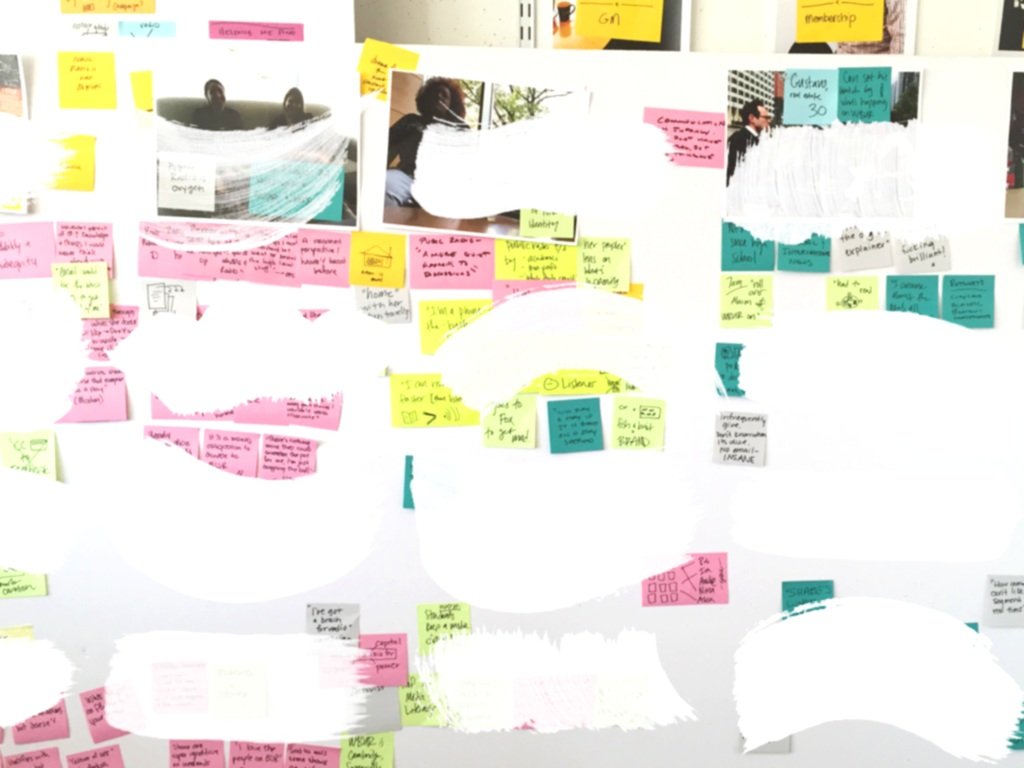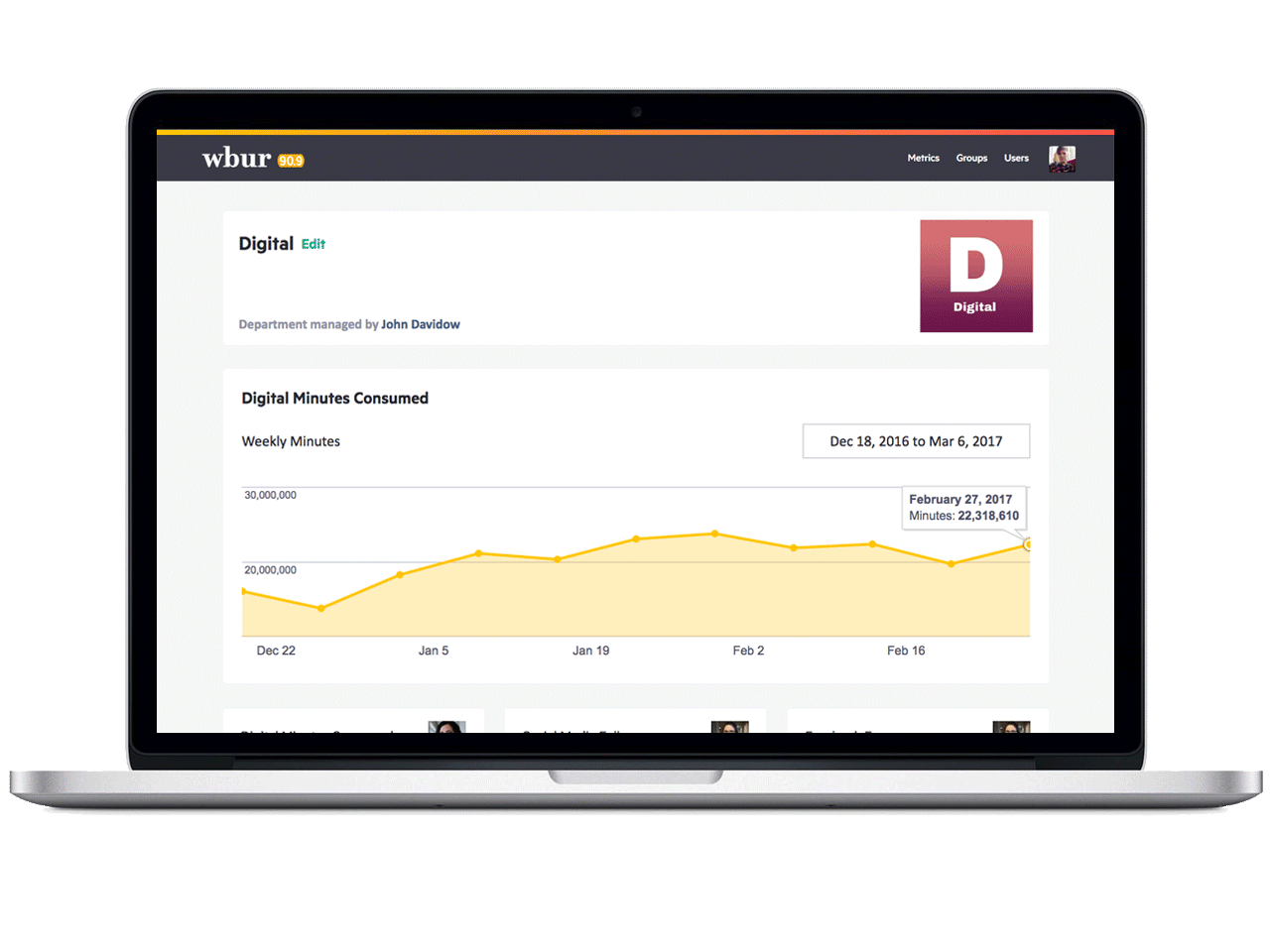
Public Radio BizLab
From 2015-2017 I served as Executive Director of a business innovation unit tethered to WBUR 90.9 in Boston. I was responsible for launching the lab with a starting budget of $500k, conducting research to inform tests, and raised $1M in grant funding for future operation of the lab. The milestones of that time are below.
In partnership with the Knight Foundation, WBUR launched the Public Radio BizLab in early 2015, believing it is critical to invest in innovation to develop new and sustainable business models to support journalism.
The mission of BizLab was simple but challenging: to spend five years developing and testing ideas that change the way we think about funding and innovation for public radio in order to provide all public media organizations with new and creative business models that sustain their excellent journalism.
Creating a strong foundation & understanding of WBUR’s listeners from which to design new experiments.
In its first year, BizLab started by introducing a pioneering Human-Centered Participatory Research & Design methodology to the station. In partnership with IDEO, BizLab conducted an introductory study examining listener needs and behaviors.
Increasing Organizational Transparency
BizLab led a participatory research & design effort to identify WBUR's key operational metrics and determine how to best share them across the station. After coaching senior managers to incorporate measurement and feedback cycles into weekly meetings, we developed a new cloud-based platform to support this practice across public media. Here’s a look at the steps we took.
1 Analytics Audit
We began the project by speaking with 22 members of the organization who gathered, interpreted, or relied upon statistical data at WBUR, and created a 15-page ethnographic report detailing our findings.
By sharing a holistic understanding of the organization with its leadership, we developed a common frame of reference about current strengths and weaknesses that allowed us to create grounded solutions for the problems we identified.
2 Operations Upgrade
After the audit, we created a three-month curriculum to improve data literacy at the station. We coached WBUR’s leadership through the course of translating their high-level strategy into actionable plans with quantifiable results.
By facilitating weekly leadership meetings, we worked with station managers to come to a consensus about what metrics they needed to be tracking and sharing on a station-wide basis.
3 Visual Prototype
As station staff began to see the interrelation of each department's KPIs, we engaged them in a participatory design process to imagine what a station-wide analytics dashboard might look like.
Pushing Google Sheets to its limits, we developed a prototype system for everyone at the station to use. By the time the operations upgrade was complete, staff members were reporting and reflecting on over 180 common metrics every week.
4 Adaptable Interface
Learning from how the prototype was used, we developed a full-fledged analytics platform for public radio. The Dynamic Growth Dashboard allows a station to track, share and visualize virtually any metric their team members need to monitor.
Daily podcast downloads sit side-by-side with monthly membership donations and quarterly Nielsen reports. Built using Ruby on Rails and Google Charts, the web-based dashboard was previewed in summer 2016 at the Public Media Development and Marketing Conference.




Creating Opportunities to Learn
During BizLab’s second year these two initiatives were united with a small test project called The Magic Pill, an interactive email-based podcast experience, designed following Human-Centered principles and measured with the Dashboard prototype. BizLab proved the success of its methodology by creating a new product that achieved an incredibly high rate of engagement: while the standard media industry open rate for emails is 19% we achieved an average of 90% with The Magic Pill. The significant results of this small project were enough to win WBUR a 2017 regional Edward R. Murrow award for Excellence in Innovation.
“What does our audience actually look like?”
Groundbreaking study of public radio listeners led by a team of journalists under BizLab’s guidance. As one of the largest national public radio stations, WBUR was finding it difficult to define the nature and needs of its changing audience. BizLab led an in-depth research study to address this knowledge gap and taught both journalists and station managers how to derive actionable insights from their newfound understanding.
1 Participatory Research
Realizing that the basics of ethnography aren't that different from the fundamentals of a newsroom, we adopted an experimental approach in which we guided the station's journalists through the process of designing and conducting a massive user study. Working together under our advisement, 36 individuals from WBUR decided to ask and answer the simple yet crucial question: "what does our audience actually look like?"
2 Designing the Study
The dry summaries from the Nielsen Scarborough reports weren't enough to develop a rich picture of WBUR's audience, so we worked with the newsroom team to identify 40 data points that painted more nuanced portraits of their listeners. We created an open-ended online survey, carefully choosing the narrative arc of the questions to draw out information about our audience's identities and opinions—without imposing our worldview on them.
3 Strategic Survey Distribution
Because the station was not yet in the habit of listening to their audience, we stressed the importance of making sure the team heard from the folks at the fringes of the WBUR community who may have not felt welcome to speak up before. To make that intention clear, we named the survey “Let’s Talk,” and crafted a strategic messaging and distribution plan that was as inclusive and expansive as possible.
4 Listening to the Stories We Heard
During the one month survey period over 3,600 people responded with thousands of short answers and 500+ pages of essay text. The study reached more than ten times the number of people used for standard demographic reports at the station, and produced a mountain of nuanced information. Guiding the team, we analyzed all the data to form a grounded theory of WBUR's audience. And for the journalists who wanted to dive into specific areas more deeply, we coached them through the process of writing their own detailed reports.
First of Its Kind:
Opportunity Report
The output of our collaborative analysis was just as overwhelming in volume as the response from the audience. Though many WBUR staffers had joined the research team, there were others who had only a passing knowledge of the project.
To ensure that this deep understanding of the audience would be shared by all employees and affiliates of the organization, we published a 160-page "Opportunity Report" book that encapsulated the extensive findings from the study and offered a roadmap for future human-centered innovation.
Innovation Workshop
Building upon the research conducted by the station's journalists, BizLab organized a workshop for WBUR's management and outside collaborators to brainstorm new avenues for innovation. Distributing the books to participants ahead of time enabled our time together to be productive.
By leading the group through empathy-building exercises and design prototyping sprints, BizLab and the workshop participants generated a portfolio of 20 unexplored opportunities for the station to begin testing.
Funding the Future of BizLab
As a not-for-profit entity, BizLab was required to think of creative ways to foster innovation while also supporting itself. While simultaneously conducting the audience study, BizLab engaged and gained the support of The Knight Foundation and The Corporation for Public Broadcasting. $1M in grants fueled the work of Public Radio BizLab after I left the organization.









